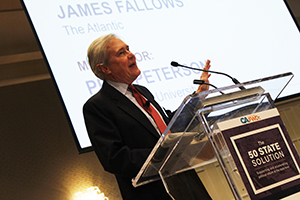Starting in 2013, Atlantic national correspondent James Fallows embarked on a journey to look for America from the seat of a single-engine plane, flying into “smaller” cities across the country. Once on the ground, the view from there showed a split between how people think the country at-large is doing and how they talked about their own community and good things happening there.
“Many people are discouraged by what they hear and read about America. But the closer they are to the action at home, the better they like what they see,” said Fallows, in an interview with CA Fwd. Watch the video above for more from our interview.
One thing that you learn from his story is there are around 5,000 small public airports scattered across the country. Another insight is that people's opinion of their community and the possibility to create positive local change in schools, the economy and other aspects grow when government is closer to the people, as CA Fwd has been talking about since forming in 2007.
“If you ask people if you like Hillary Clinton, if you like Donald Trump, you can start a polarized argument,” said Fallows. “But most of the time that didn't poison the way people are doing business at the local level. Usually they're interested in what would bring jobs their community, what is the future for the children, how the schools are doing, etc.”
 Fallows spoke at CA Fwd's 50 State Solution event in January, when political reform organizations and those interested in reform gathered to find ways to link and support work happening on the state and local level across the U.S. The goal is to generate ways that state-level reform leaders can accelerate the innovative experiments that are taking place everywhere.
Fallows spoke at CA Fwd's 50 State Solution event in January, when political reform organizations and those interested in reform gathered to find ways to link and support work happening on the state and local level across the U.S. The goal is to generate ways that state-level reform leaders can accelerate the innovative experiments that are taking place everywhere.
“Even before November, we recognized that no matter who won the election, it was unlikely that Washington D.C. was going to become the epicenter for political reform in America today,” said Chris Gates, executive vice president of external affairs at the Council on Foundations and leader of the team that launched the 50 State Solution.
For example, 13 states recently established citizens redistricting commissions and 28 states adopted automatic voter registration. Meanwhile, gridlock and dysfunction at the federal level keeps reinforcing the negative image of the country as a whole that people relayed to Fallows.
“That is why local resilience and adaptability of the kind we have witnessed deserve nationwide attention,” Fallows wrote in his story about his journey.
Fallows also noted that early 20th century innovations in education, regulation, and public services grew from the state and local level.
“It's very important to pay attention to the history of the previous Gilded Age, the late 19th century, and the reforms that followed that, which were largely driven by state-by-state, city-by-city innovation,” said Fallows.
While we often hear about the national story of the “Big Sort” — the gathering of politically like-minded people in certain regions — Fallows argues that creativity, startups and diversity are still spreading out as talented people migrate across the country.
Similarly, the goal of the 50 State Solution initiative is to highlight and share nationally the successes and failures of innovative political reforms springing from cities and states changing how they conduct elections, disclose and regulate campaign financing, and perform redistricting.
A final lesson here could be, if you don't like the view from the top, get down to the bottom, go local and get involved with improving the things you care about. Most likely, there are a lot of people who care about the same things.

